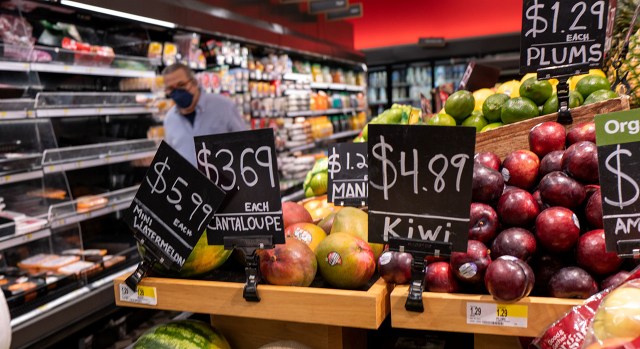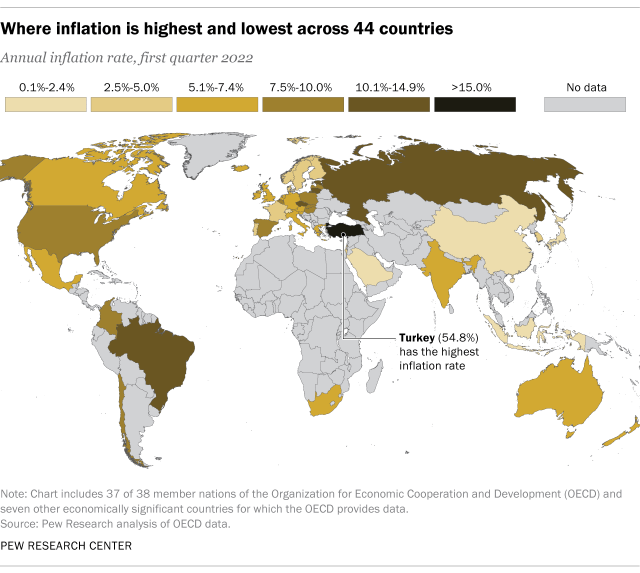
Two years ago, with millions of people out of work and central bankers and politicians striving to lift the U.S. economy out of a pandemic-induced recession, inflation seemed like an afterthought. A year later, with unemployment falling and the inflation rate rising, many of those same policymakers insisted that the price hikes were “transitory” – a consequence of snarled supply chains, labor shortages and other issues that would right themselves sooner rather than later.
Now, with the inflation rate higher than it’s been since the early 1980s, Biden administration officials acknowledge that they missed their call. According to the latest report from the Bureau of Labor Statistics, the annual inflation rate in May was 8.6%, its highest level since 1981, as measured by the consumer price index. Other inflation metrics also have shown significant increases over the past year or so, though not quite to the same extent as the CPI.
With inflation in the United States running at its highest levels in some four decades, Pew Research Center decided to compare the U.S. experience with those of other countries, especially its peers in the developed world. An earlier version of this post was published in November 2021.
The Center relied primarily on data from the Organization for Economic Cooperation and Development (OECD), most of whose 38 member states are highly developed democracies. The OECD collects a wide range of data about its members, facilitating cross-national comparisons. We chose to use quarterly inflation measures, both because they’re less volatile than monthly figures and because they were available for all but one OECD country (Costa Rica, which joined the OECD in May 2021). Quarterly inflation data also were available for seven non-OECD countries with sizable national economies, so we included them in the analysis as well.
For each country, we calculated year-over-year inflation rates going back to the first quarter of 2010 and ending in the first quarter of this year. We also calculated how much those rates had risen or fallen since the start of the COVID-19 pandemic in the first quarter of 2020.
To get a sense of longer-term inflation trends in the U.S., we analyzed two measures besides the commonly cited consumer price index: The Consumer Price Index Retroactive Series (R-CPI-U-RS) from the Bureau of Labor Statistics, and the Personal Consumption Expenditures Price Index from the Bureau of Economic Analysis.
Inflation in the United States was relatively low for so long that, for entire generations of Americans, rapid price hikes may have seemed like a relic of the distant past. Between the start of 1991 and the end of 2019, year-over-year inflation averaged about 2.3% a month, and exceeded 5.0% only four times. Today, Americans rate inflation as the nation’s top problem, and President Joe Biden has said addressing the problem is his top domestic priority.
But the U.S. is hardly the only place where people are experiencing inflationary whiplash. A Pew Research Center analysis of data from 44 advanced economies finds that, in nearly all of them, consumer prices have risen substantially since pre-pandemic times.

In 37 of these 44 nations, the average annual inflation rate in the first quarter of this year was at least twice what it was in the first quarter of 2020, as COVID-19 was beginning its deadly spread. In 16 countries, first-quarter inflation was more than four times the level of two years prior. (For this analysis, we used data from the Organization for Economic Cooperation and Development, a group of mostly highly developed, democratic countries. The data covers 37 of the 38 OECD member nations, plus seven other economically significant countries.)
Among the countries studied, Turkey had by far the highest inflation rate in the first quarter of 2022: an eye-opening 54.8%. Turkey has experienced high inflation for years, but it shot up in late 2021 as the government pursued unorthodox economic policies, such as cutting interest rates rather than raising them.

The country where inflation has grown fastest over the past two years is Israel. The annual inflation rate in Israel had been below 2.0% (and not infrequently negative) every quarter from the start of 2012 through mid-2021; in the first quarter of 2020, the rate was 0.13%. But after a relatively mild recession, Israel’s consumer price index began rising quickly: It averaged 3.36% in the first quarter of this year, more than 25 times the inflation rate in the same period in 2020.
Besides Israel, other countries with very large increases in inflation between 2020 and 2022 include Italy, which saw a nearly twentyfold increase in the first quarter of 2022 compared with two years earlier (from 0.29% to 5.67%); Switzerland, which went from ‑0.13% in the first quarter of 2020 to 2.06% in the same period of this year; and Greece, a country that knows something about economic turbulence. Following the Greek economy’s near-meltdown in the mid-2010s, the country experienced several years of low inflation – including more than one bout of deflation, the last starting during the first spring and summer of the pandemic. Since then, however, prices have rocketed upward: The annual inflation rate in Greece reached 7.44% in this year’s first quarter – nearly 21 times what it was two years earlier (0.36%).
Annual U.S. inflation in the first quarter of this year averaged just below 8.0% – the 13th-highest rate among the 44 countries examined. The first-quarter inflation rate in the U.S. was almost four times its level in 2020’s first quarter.
Regardless of the absolute level of inflation in each country, most show variations on the same basic pattern: relatively low levels before the COVID-19 pandemic struck in the first quarter of 2020; flat or falling rates for the rest of that year and into 2021, as many governments sharply curtailed most economic activity; and rising rates starting in mid- to late 2021, as the world struggled to get back to something approaching normal.
But there are exceptions to that general dip-and-surge pattern. In Russia, for instance, inflation rates rose steadily throughout the pandemic period before surging in the wake of its invasion of Ukraine. In Indonesia, inflation fell early in the pandemic and has remained at low levels. Japan has continued its years-long struggle with inflation rates that are too low. And in Saudi Arabia, the pattern was reversed: The inflation rate surged during the pandemic but then fell sharply in late 2021; it’s risen a bit since, but still is just 1.6%.
Inflation doesn’t appear to be done with the developed world just yet. An interim report from the OECD found that April’s inflation rate ran ahead of March’s figure in 32 of the group’s 38 member countries.

"world" - Google News
June 15, 2022 at 10:05PM
https://ift.tt/YzJkcVm
Inflation around the world, over the past two years - Pew Research Center
"world" - Google News
https://ift.tt/dKQUzCj
https://ift.tt/65L7vKg
Bagikan Berita Ini














0 Response to "Inflation around the world, over the past two years - Pew Research Center"
Post a Comment